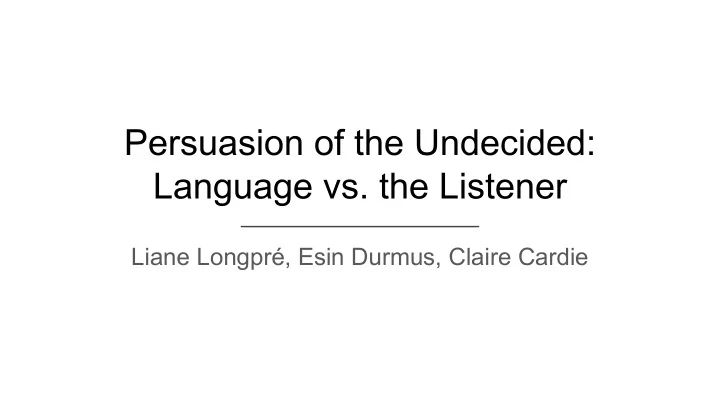

Persuasion of the Undecided: Language vs. the Listener Liane Longpré, Esin Durmus, Claire Cardie
Examining Language Effects in Persuasion Research Goal: explore the linguistic factors that determine and define persuasive arguments
Prior Work in NLP on Persuasion Pre- and post-debate vote outcomes of IQ2 debates (Zhang et al., 2016) PRO CON Before the debate After the debate
Prior Work in NLP on Persuasion Individual-level vote outcome prediction, considering audience characteristics (Durmus and Cardie, 2018) Voter 1 Voter 2 Voter 3
Prior Work in Social and Political Science 2005 British general 2008, 2012 U.S. European election election presidential debates campaigns Undecided voters are Critical portion of Affiliated voters adjust more susceptible to debate to undecided positions based on campaign persuasion voters are content-rich subjective perceptions statements of campaigns (Kosmidis and Xezonakis, 2010) (Schill and Kirk, 2014) (Adams et al., 2011) Key difference in the persuasion of undecided and decided audience members
Research Question What language features are important for persuasion? Do these features differ for individuals who are persuaded from the middle versus persuaded from the opposing side ?
Hypothesis ● The important linguistic features for persuasion differ between a priori undecided and a priori decided audience members ● Audience features provide important context
Dataset Dataset of online debates (Durmus and Cardie, 2018) ● Collection of ~67k debates from Debate.org ● User information for ~36k users ● Varied debate topics (i.e. Politics, Religion, Movies, Science, etc.)
Dataset ... Example user profile
Dataset ... Example user profile
Dataset Example debate titled “HATE SPEECH LAWS ARE A GOOD IDEA”
Dataset User votes on debates
Experimental Approach 1. Build a classifier to predict persuasion vote outcomes ○ Prediction task: Given an individual voter, predict which debater/side (PRO or CON) the voter will be convinced by after the debate 2. Examine what features are most important for prediction accuracy
Distinct Cases of Persuasion Voter 1 Voter 2
Experimental Approach Divide the dataset into two subsets: from-middle from-opposing features model prediction Examples ... from-opposing features model prediction from-middle ... Dataset
Experimental Approach Divide the dataset into two subsets: from-middle from-opposing features model prediction Examples ... differences? from-opposing features model prediction from-middle ... Dataset
Predictive Model Audience Features Logistic Regression Classifier PRO CON Linguistic Features
Audience Features ● gender ● matching ideology ● opinion similarity ● decidedness ● persuadability
Audience Features ● gender ● matching ideology ● opinion similarity ● decidedness ● persuadability Example user profile and corresponding feature encodings
Linguistic Features Lexical Features Style Features Semantic Features Argumentation Features TF-IDF length sentiment assessment empathy modal verbs personal pronouns subjectivity authority inconsistency swear words referring to opponent connotation conditioning necessity spelling errors use of citations politeness contrasting possibility punctuation links emphasizing priority generalizing rhetorical questions desire difficulty
Results: Audience vs Linguistic Features Accuracy of Model FROM-MIDDLE FROM-OPPOSING Majority Baseline 57.43% 59.42% All Features 69.01% 67.22% Audience Features Only 61.47% 61.54% Linguistic Features Only 66.95% 66.65% Result: linguistic features are more important for predictive accuracy
Results: Best-Performing Feature Sets Accuracy of Model FROM-MIDDLE FROM-OPPOSING Majority Baseline 57.43% 59.42% All Features 69.01% 67.22% Audience Features Only 61.47% 61.54% Linguistic Features Only 66.95% 66.65% Best-performing Features 69.17% 68.21% Result: not all linguistic features are helpful in predictive accuracy
Results: Best-Performing Feature Sets FROM-MIDDLE FROM-OPPOSING Features Not In Set Features Not In Set use of citations subjectivity referring to opponent modals swear words bi-/tri-gram TF-IDF
Conclusion ● Key Result: Linguistic feature differences correspond to rhetorical styles found to be effective on undecided and decided audiences ● Key Takeaway: the importance of studying undecided and decided audiences separately
End For questions and suggestions, email lfl42@cornell.edu Thank you!
Recommend
More recommend